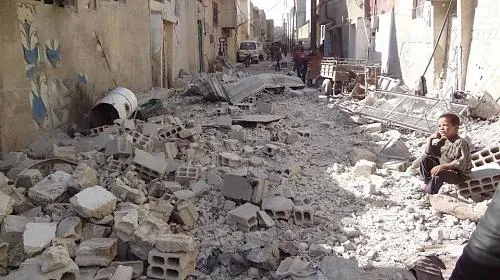CARE welcomes the announcement of a ceasefire brokered by the US and Russia that came into effect at sunset on Monday, the beginning of the important Muslim holiday Eid al-Adha. The desperately needed pause in fighting offers a glimpse of hope for hundreds of thousands of people in besieged areas inside Syria.
“People can breathe again. They are now able to do things for the first time that we consider as normal, they sleep through the night, visit relatives in other neighborhoods, let children play in the streets without fear,” says Sonja Meyer, who works for CARE’s emergency team for the Syria response.
However, in some areas which have been under siege for the past months, people are still waiting for desperately needed humanitarian assistance. In Madaya and other cities starvation and excruciating pain as a result of injuries or uncured diseases have driven dozens of people into suicide, including children.
“CARE partners on the ground say that it is hard for them to believe that people have been exposed to such levels of suffering. To them it feels like the world is watching, not doing enough to ease their pain,” explains Meyer. “The price for a can of powdered milk has reached 90 USD. People have lost everything and no one can afford to buy food, if it is even available for purchase. It is unbearable for parents to watch their children starve slowly.”
Two days after the ceasefire came into effect, conflicting parties demanded to control the distribution of aid. CARE and partners insist that local humanitarian organizations need to be supported and enabled to lead on humanitarian efforts. Restrictions related to sanctions that affect the delivery of aid need to be lifted.
“Local partners urgently need more funding to be able to continue their support,” said Meyer. “Some are afraid that the focus on the UN cross-line convoys will have the effect that all the resources will be dedicated to UN distributions while sustainable projects like agricultural farming are running out of money.”
Within Syria, more than 13.5 million people, including six million children, are in need of humanitarian assistance and protection. So far, CARE has reached more than one million people inside Syria. Most recently, CARE and other humanitarian organizations have distributed food, toys and clothing to children. Toys such as swings and slides have been put up in the streets for children to play. Through partner organizations CARE delivered food parcels, supported community kitchens in setting up food stocks and cooking gas, as well as provided help in agricultural production for self-reliance.
While there is a lot of hope that the agreement might pave the way for a political solution of the conflict, people also weary of what such a political solution might imply. They are afraid that they would be forced to leave their homes because of forced evacuations that happened in some of the besieged areas.
“Syrians have seen too many international announcements and resolutions amount to nothing. Russia and the USA must make sure their agreement translates to a real and lasting halt to violence on the ground,” says Meyer.
CARE continues to call for all parties to the conflict to immediately end attacks on civilians and allow the unimpeded delivery of humanitarian assistance to those in need. Human lives must not be used as bargaining chips, forced to choose between being bombed, starved to death, or fleeing their homes to unknown consequence.
-End-
Media Contact: Holly Frew +1.770.842.6188 hfrew@care.org

